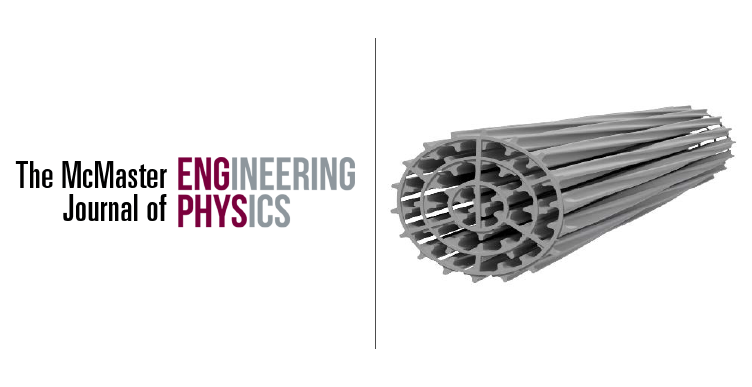Simulated Heat Transfer out of a Metallic Cruciform CANDU Fuel Element
Abstract
Preliminary FlexPDE simulations were run to quantify the temperature distribution and surface heat flux conditions in a theoretical Uranium-Zirconium alloy, helical, cruciform shaped fuel element. A thermohydraulic model of the CANDU-6 pressure tube was created and used to predict a single phase convection heat transfer coefficient of 6.59 W/cm2K for a metal fuel element bundle, a 32% enchantment compared to conventional fuel bundle. At the conventional CANDU fuel pellet centerline melting power level of 70 kW/m, the metal alloy fuel had a simulated peak temperature of 610C, which is 1115C below its solidus melting temperature. The heat flow inside the fuel element was not radially symmetrical, and the surface normal to the short axis of the cruciform had the highest heat flux. The simulation indicates the high heat flux regions would produce sustained subcooled nucleate boiling at linear power levels above 40 kW/m.References
CANDU 6 Technical Summary. Atomic Energy Canada Ltd.,
R.D. Page. Canadian Power Reactor Fuel. Atomic Energy
Canada Ltd.
J.H. Harding and D.G. Martin. A recommendation for the thermal
conductivity of uo2. Journal of Nuclear Materials, 166(3):
– 226, 1989.
A Harms. An Introduction to the CANDU Nuclear Energy Conversion
System. McMaster University, 1972. Retrieved from:
https://canteach.candu.org/Content
A Manzer. Candu fuel performance. Technical report, Atomic
Energy Canada Ltd., Mississauga, Ontario, Canada, 1996.
Song Wenhui and A Manzer. Candu fuel performance. AECL,
Shanghai Nuclear Design and Research Institute.
A Totemeier, N Shaprio, and S Vaidyanathan. Lightbridge corporation’s
advanced metallic fuel.
Marcio Soares Dias and Joao Roberto L de Mattos. Uraniumzirconium
based alloys part i: reference points for thermophysical
properties.
Gerard L. Hofman, R. G. Pahl, C. E. Lahm, and D. L. Porter.
Swelling behavior of u-pu-zr fuel. Metallurgical Transactions A,
(2):517–528, Feb 1990.
Yeon Soo Kim, Tae Won Cho, and Dong-Seong Sohn. Thermal
conductivities of actinides (u, pu, np, cm, am) and uraniumalloys
(uzr, upuzr and uputruzr). Journal of Nuclear Materials,
(1):272 – 280, 2014.
Masayuki MURABAYASHI, Shigenori TANAKA, and Yoichi
TAKAHASHI. Thermal conductivity and heat capacity of
zircaloy-2, -4 and unalloyed zirconium. Journal of Nuclear Science
and Technology, 12(10):661–662, 1975.
J.C. Luxat. Two-phase flow: Flow regimes, pressure drop, boiling
heat transfer, and critical heat flux. McMaster Engineering
Physics 4NE3 Lecture Notes, .
Boris Lekakh, Mujid S Kazimi, and John E Meyer. Boiling heat
transfer for high velocity flow of highly subcooled water. Technical
report, Dept. of Nuclear Engineering, Massachusetts Institute
of Technology, 1999.
Yunus A Cengel, John M Cimbala, and Robert H Turner. Fundamentals
of thermal-fluid sciences. McGraw-Hill, 2012.
J.C. Luxat. Nuclear heat transport: Single phase flow and heat
transfer. McMaster Engineering Physics 4NE3 Lecture Notes, .
M.M.K. Bhuiya, M.S.U. Chowdhury, M. Saha, and M.T. Islam.
Heat transfer and friction factor characteristics in turbulent
flow through a tube fitted with perforated twisted tape inserts.
International Communications in Heat and Mass Transfer, 46
(Supplement C):49 – 57, 2013.
N. Matsunaga and A. Nagashima. Transport properties of liquid
and gaseous d2o over a wide range of temperature and pressure.
Journal of Physical and Chemical Reference Data, 12(4):933–
, 1983.
B.S. Petukhov and L.I. Roizen. General dependences for heat
treatment at turbulent fluid flow in an annulus. Izvestiya of the
USSR Academy of Sciences. Energy and transport, (1):103, 1967.
Published
Issue
Section
License
Authors who publish with this journal agree to the following terms:Authors retain copyright and grant the journal right of first publication with the work simultaneously licensed under a Creative Commons Attribution License that allows others to share the work with an acknowledgement of the work's authorship and initial publication in this journal.
Authors are able to enter into separate, additional contractual arrangements for the non-exclusive distribution of the journal's published version of the work (e.g., post it to an institutional repository or publish it in a book), with an acknowledgement of its initial publication in this journal.
Authors are permitted and encouraged to post their work online (e.g., in institutional repositories or on their website) prior to and during the submission process, as it can lead to productive exchanges, as well as earlier and greater citation of published work.


